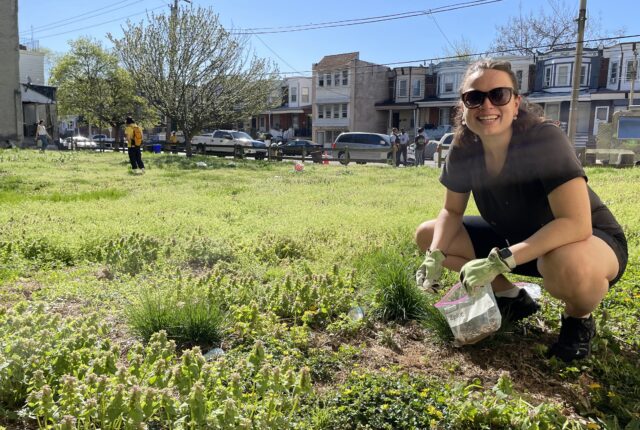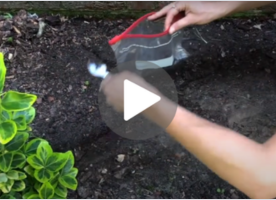
Lead
Lead poisoning remains a major issue in Philadelphia. In 2022, 6% of children screened by the Philadelphia Public Health Department had elevated blood lead levels. Non-Hispanic Black children have the highest rates of lead exposure. Since 1995, faculty affiliated with the CEC designed and implemented a service learning course for Penn students called “Speaking about Lead in West Philadelphia.” Richard Pepino, the former Deputy Director of the CEC, and now Maria Antonio-Andrews, CEET member, have taught the course to Penn students who bring the content to Philadelphia elementary students. Collection and testing of thousands of soil samples for lead have occurred through this course and other individual student projects. This data formed the foundation for our lead soil map.
Lead Soil Map
CEC has worked with healthcare professionals, governmental entities, students, and communities to consolidate historic lead soil data and collect samples of soil to test for lead contamination using a Delta X-Ray Fluorescence (XRF) portable analyzer. We currently have over 3,900 soil samples in 86% of the census tracts in Philadelphia. Explore the map below. Each colored point on the map represents one soil sample. In cities like Philadelphia where there are multiple sources of lead exposure, the EPA considers 100 ppm as the maximum lead soil level for children’s play areas.
Disclaimer: These points may not be exact. Locations are sometimes estimates based on near addresses or cross streets. Also, lead soil levels vary greatly even within inches. Any high or low lead level in soil may not represent the lead risk of the entire property.
Get Involved
Are you interested in having the soil in your yard tested for lead? Review the video on how to collect a sample and contact us. We would also love your help obtaining soil samples in neighborhoods in Philadelphia that have not yet been tested! If you would like to help, all you need is a plastic spoon, a permanent marker, and a clean plastic bag.
Learn how to collect soil samples
Lead Resources
Discover our extensive lead resources to learn about the dangers of lead exposure, prevention strategies, and solutions for creating safer environments. Learn how to collect soil samples and submit them for testing by the Community Engagement Core to understand the scope of lead contamination in your yard.


Lead: It’s Still a Problem (English & Spanish)
Brochure Information on lead, the health effects of lead poisoning, and ways to reduce exposure.
How to Collect Soil Samples for Lead Testing
Video This video details how to collect a soil sample and get GPS coordinates for lead testing.
Testing for Lead Based Paint
Video Demonstration of how to test for lead based paint and provides links to resources if you discover you have lead-based paint in your home.
Lead in Household Items
Video Information on how lead exposure can occur in the home through various household items, including pottery, spices, and old toys.
Effects of Lead on Children’s Health
Infographic Infographic on the effects of lead on children’s health.
Understanding Lead Soil Concentrations
Document Details on interpreting soil lead concentrations in parts per million (ppm) and action steps to take.
Is Your Water Pipe Made of Lead?
Infographic Step-by-step guide on how to check if you have lead pipes and ways to reduce exposure to lead through drinking water.
Mandatory Lead Certification for all Philadelphia Contractors
Policy brief Policy brief for establishing a bill in Philadelphia to require all contractors to receive lead safe certification.CEET Publications on Lead
The CEET conducts research that links environmental exposures to adverse outcomes and disease, particularly at susceptible stages across the lifespan, and translates its findings to improve public health. View published journal articles by CEET researchers on topics related to lead.
O’Shea MJ, Toupal J, Caballero-Gómez H, McKeon TP, Howarth MV, Pepino R, Gieré R. Lead Pollution, Demographics, and Environmental Health Risks: The Case of Philadelphia, USA. Int J Environ Res Public Health. 2021 Aug 27;18(17):9055. doi: 10.3390/ijerph18179055. PMID: 34501644; PMCID: PMC8431549.
View in PubMedCaballero-Gómez H, White HK, O’Shea MJ, Pepino R, Howarth M, Gieré R. Spatial Analysis and Lead-Risk Assessment of Philadelphia, USA. Geohealth. 2022 Mar 1;6(3):e2021GH000519. doi: 10.1029/2021GH000519. PMID: 35340281; PMCID: PMC8934574.
View in PubMedLiu J, Portnoy J, Raine A, Gladieux M, McGarry P, Chen A. Blood lead levels mediate the relationship between social adversity and child externalizing behavior. Environ Res. 2022 Mar;204(Pt D):112396. doi: 10.1016/j.envres.2021.112396. Epub 2021 Nov 18. PMID: 34801542; PMCID: PMC10117419.
View in PubMedHalabicky OM, Ji X, Gur RE, Gur RC, Yan C, Chen A, Liu J. Childhood lead exposure and sex-based neurobehavioral functioning in adolescence. Neurotoxicology. 2022 Dec;93:1-8. doi: 10.1016/j.neuro.2022.08.008. Epub 2022 Aug 19. PMID: 35988749; PMCID: PMC10433489.
View in PubMed